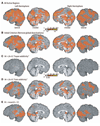Statistical criteria in FMRI studies of multisensory integration
- PMID: 15988040
- PMCID: PMC2843559
- DOI: 10.1385/NI:3:2:093
Statistical criteria in FMRI studies of multisensory integration
Abstract
Inferences drawn from functional magnetic resonance imaging (fMRI) studies are dependent on the statistical criteria used to define different brain regions as "active" or "inactive" under the experimental manipulation. In fMRI studies of multisensory integration, additional criteria are used to classify a subset of the active brain regions as "multisensory." Because there is no general agreement in the literature on the optimal criteria for performing this classification, we investigated the effects of seven different multisensory statistical criteria on a single test dataset collected as human subjects performed auditory, visual, and auditory- visual object recognition. Activation maps created using the different criteria differed dramatically. The classification of the superior temporal sulcus (STS) was used as a performance measure, because a large body of converging evidence demonstrates that the STS is important for auditory-visual integration. A commonly proposed criterion, "supra-additivity" or "super-additivity", which requires the multisensory response to be larger than the summed unisensory responses, did not classify STS as multisensory. Alternative criteria, such as requiring the multisensory response to be larger than the maximum or the mean of the unisensory responses, successfully classified STS as multisensory. This practical demonstration strengthens theoretical arguments that the super-additivity is not an appropriate criterion for all studies of multisensory integration. Moreover, the importance of examining evoked fMRI responses, whole brain activation maps, maps from multiple individual subjects, and mixed-effect group maps are discussed in the context of selecting statistical criteria.
Figures






References
-
- Alais D, Burr D. The ventriloquist effect results from near-optimal bimodal integration. Curr. Biol. 2004;14:257–262. - PubMed
-
- Amedi A, Jacobson G, Hendler T, Malach R, Zohary E. Convergence of visual and tactile shape processing in the human lateral occipital complex. Cereb. Cortex. 2002;12:1202–1212. - PubMed
-
- Amedi A, Malach R, Hendler T, Peled S, Zohary E. Visuo-haptic object-related activation in the ventral visual pathway. Nat. Neurosci. 2001;4:324–330. - PubMed
-
- Beauchamp MS. See me, hear me, touch me: multisensory integration in lateral occipital-temparal cortex. Curr, opin. Neurobiol. 2005;15:145–153. - PubMed
Publication types
MeSH terms
Grants and funding
LinkOut - more resources
Full Text Sources

